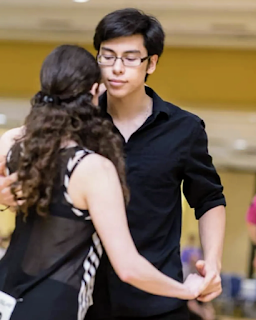Position, engagement, intention
I'll admit, I don't think about how to teach west coast swing very often. I don't have the intention of becoming a travelling professional, I have little interest in working with group classes, and having to conceive of some sort of methodology to approach beginners is something I don't want to try and wrap my head around (my wife is amazing at it, so I leave that to her). But something I have been trying to work more with this year is learning more efficiently, myself.
I'm at a stage now wherein things seem to be coming together. The interconnectedness of different theories and the commonalities of what is taught by the best in the world are making more sense now rather than less, which I think is a good sign. But there are still plenty of skills to be developed--I gravitate toward physical skills with a firm biomechanical basis, given my background--and I do want to pick them up efficiently.
Quick aside regarding any target elements, here. There is no one 'right' way to do anything in this dance, I firmly believe that now. But, there is definitely a narrowing of data points at the very top tier, if one regards the most successful dancers in the champions division certain things happen very similarly even though different bodies, styling choices, etc. might make these elements look a bit different. So I do firmly believe that there are a whole lot of 'wrong' things to do, even if there isn't just one single 'right' way. The target for a particular technique (among several that are workable) might not be a bullseye but it does probably resemble the innermost circle on a target. It isn't like you can do absolutely whatever you want in terms of your physical technique and still have workable west coast swing dances with a majority of people in the world.
With any element that we're honing in on, there are three components that have to all come together for it to work well--that is, reliably, efficiently, in a mechanically sound way.
The most obvious one is positioning. West coast swing is a visual art form, competitively, and competition is a large part of the culture. Unless you dance with someone, your biggest impression of them will be visual (and even if you dance with them, your own dance and their adaptation to it will affect your impression of them). So, in learning, most people focus on the visual aspect. What places should we put our bodies in, what looks good? The problem is that what looks the best especially to an less trained eye won't be athletically efficient. Creating a nice shape often results in forgetting that the shape has to move and adapt easily. Positioning in many cases sets us up for proper engagement through the center, through the frame, in the lower body; or simply allows for efficient movement in the case of completed weight transfers.
Engagement matters just as much. Alignment could be perfect for a balanced weight transfer but without the right muscles involved, the position will be just that, a snapshot unable to shift. There are a number of different philosophies concerning muscle engagement for the core, frame, or really anything (many are sadly dogmatic) but in any event, striving for relaxation throughout the entire body or 'minimal muscle use' will definitely result in at the very least difficulty moving anywhere on the floor. Engagement is hard to learn in an isolated fashion. After all, flexing ones abs, lats, etc. won't accomplish much by themselves.
If positional cues are external (i.e. push through the floor, rather than try to straighten your leg) proper engagement can often be accomplished along the way if the positioning is properly is maintained. This intent is going to be the driving force for any element to operate. Here's a basic example. If I strive for some sort of aesthetically pleasing, isolated 'anchor' position by myself while flexing my lats and trying to exert X amount of poundage on my connected hand, the resulting frankensteining of pieces probably won't work together very well. On the other hand, starting with a completed weight transfer and seeking distance to counter my partner will provide the proper engagement if the right positions are maintained.
Here's another example putting it all together: initiations for leaders. Positioning--if your hand moves before your body, it'll be an 'arm lead'. But, even if timing is right and the body moves first, the lead will still feel 'rough' if frame engagement isn't good or the arm or forearm are overly tight. Intention matters, too. Pushing through the anchored foot and leg or sending the center back to initiate, following through by driving through the elbow rather than squeezing with the fingers--there are options for 'right' ways to produce power that is still comfortable to a follow but certain factors have to line up no matter the exact methodology.
I think it's pretty common in our dance to only see one or two out of these three taught for any element. How often have you heard either an isolated positional goal ('pull your shoulders back') or engagement goal ('squeeze your lats') or some sort of intention just by itself without any further explanation? I really believe that all three are needed. Positioning has to be mechanically efficient for anything to work well for your body, the intention of movement (or not) defines how the pieces are going to behave. Engagement makes movement and stability possible, and even if it isn't taught directly knowing what is supposed to be engaged should definitely clarify whether the completed element is going to work properly.

Comments
Post a Comment